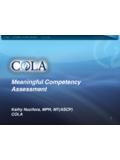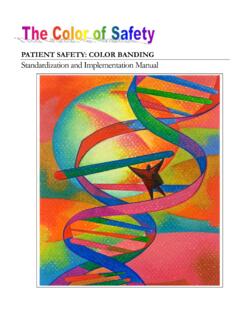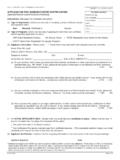Transcription of Personnel Training & Competency Assessment
1 Personnel Training &. Competency Assessment YOUR Training . PROGRAM SHOULD. HAVE DEFINED. OBJECTIVES, METHODS, AND Training . MATERIALS. Personnel Training . Even with the simplest of tests, errors can occur if the test is not performed correctly, ultimately having an adverse effect on patient care. Accurate and reliable test results are achieved when a test is performed following all manufacturer instructions. Proper Training and ongoing Competency Assessment will help to ensure the test is being performed correctly every time. All new employees need orientation and Training for The intent of Training is to provide the individual with YOUR lab. Every facility is different, and regardless of the knowledge and skills necessary to be competent in how much laboratory experience an individual has, their assigned duties and responsibilities. new employees must be trained in the following areas: Their assigned duties and responsibilities Additional Training may be necessary to ensure Your laboratory policies, including your system for ongoing Competency .
2 Your Training program should ensuring quality have defined objectives, methods, and Training Your laboratory procedure manual(s) materials. It should also specify a qualified individual Procedures for all of the tests the individual will be as the trainer. authorized to perform Your laboratory quality Assessment plan The trainer should be a qualified individual with Your OSHA and safety practices technical laboratory experience who regularly Your computer system (LIS), or your paper test performs the process or test procedure. The trainer requisitions, records, and reports may be an experienced lab co-worker, lab supervisor, Your HIPAA protocols or outside lab consultant. The following are important attributes of effective trainers: Current employees need ongoing Training : Good verbal skills When new processes and test procedures are Demonstrated attention to detail implemented Demonstrated attention to Good Laboratory When current processes and test procedures are Practices changed Ability to objectively evaluate the individual and the Whenever the need for additional Training is effectiveness of the Training identified ( , a failed Competency Assessment , Ability to provide constructive feedback proficiency testing failure, identified problem).
3 | | COLA, Inc. 2016. All Rights Reserved 4. Develop a Training checklist for each lab position It is important that Personnel do not report test results that includes all the pre-analytical, analytical and on patient specimens until Training is completed post-analytical processes and procedures that are and Competency is verified for each specific test associated with that job, and document all Training procedure. activities. After Training , confirm Competency before patient testing begins. A basic protocol for test procedure Training could include having the trainee: For quality test performance in your laboratory, Read the entire package insert and/or test Training must ensure that all testing Personnel are procedure to become familiar with the items listed familiar with the following for each test procedure: above The test name and purpose of the test Observe the specimen collection, handling, and The equipment necessary to perform the test processing steps used to obtain the specimen and Specimen collection and handling get it ready for testing Preparation, labeling, use, and storage of reagents, Observe as the trainer performs and documents standards, and controls all applicable maintenance, start-up and function Special requirements, safety procedures, etc.
4 Checks, calibration, and quality control procedures Instrument maintenance, function checks, and Observe as the trainer tests specimens calibration, when applicable Observe and discuss the evaluation of quality Step-by-step performance of the test procedure control result acceptability and interpretation of Quality control procedures including what specimen results constitutes acceptable results and when to report Perform all quality control procedures patients Perform the test using previously tested specimens How to recognize and interpret inconsistent and compare the results obtained results and test system problems and perform troubleshooting The trainer should evaluate the trainee's test Recommended corrective action when controls are performance and provide feedback, additional unacceptable instruction, and follow-up evaluations to ensure Necessary calculations and derivation of results, effective Training .
5 When applicable Reference ranges and critical values Personnel Training must be documented and retained Result reporting in the Personnel files of all laboratory testing Quality Assessment procedures Personnel . Personnel MUST NOT REPORT TEST RESULTS FOR. PATIENT SPECIMENS UNTIL Training IS COMPLETE. AND Competency IS VERIFIED FOR EACH TEST. PROCEDURE THEY PERFORM. Competency Assessment . Competency Assessment is the means to confirm that Data from the various methods for evaluating Training is effective and that Personnel are capable of Competency can be gathered over time and following established procedures to accurately perform placed in the Personnel file for use at the time of laboratory testing that produces quality results. scheduled Competency assessments. This will aid in the observance of actual test performance and The laboratory director must establish written policies interpretation of results for all the different tests and procedures to monitor the Competency of performed by the individual over the evaluation individuals that perform testing.
6 Period. QA reviews that either confirm the proper performance of the reviewed activities (QC, The laboratory director or technical consultant/ maintenance, calibration, turn-around times, etc.) or technical supervisor must follow those policies and identify problems can be used as data for assessing procedures to periodically evaluate the Competency Competency of the individuals involved in the activities. of all staff involved in pre-analytic, analytic, and post- Another source of data is QA reviews performed by analytic phases of testing, as well as those responsible the individual being assessed, which contain elements for supervision and consultation. This is not simply related to identifying problems and problem solving a traditional employee performance review of the skills that can be used for Competency Assessment . individual's initiative, work ethic and interpersonal skills.
7 The focus of Competency Assessment is to carefully Maintain detailed documentation of Competency evaluate the individual's continuing ability to: assessments, including clearly indicating the outcome. Perform assigned tasks according to the defined Was the individual found to be competent? process and procedure Fulfill the duties and responsibilities of their position Competency assessments should occur every six to assure accurate and reliable laboratory results. months for the first year and annually thereafter for all testing Personnel , supervisors, and technical The evaluation of each individual that performs testing consultants. Physicians and other providers that must include Assessment of actual test performance perform testing, especially microscopy, should be and interpretation of results. The Competency included. Create and follow policies and procedures to evaluation of testing Personnel must include, but is identify when an individual needs remedial Training or not limited to, the six methods required by the CLIA continuing education to improve skills.
8 Regulations and described in the table below. EVALUAT I O N M E T HOD EXA MPL E. Direct observation of patient test performance, Watch employee performroutine work processes and procedures, and use a including patient preparation; specimen handling, checklist to determine if all steps were properly completed. processing, and testing; and result interpretation Review of testing worksheets, quality control Review worksheets, documentation forms, quality control records, and PT. records, proficiency testing performance, and records for completeness, following proper policies and procedures, preventive maintenance records and follow-up of problems. Direct observation of instrument maintenance Watch employee perform instrument maintenance and function checks, and and function checks review documentation for completeness, correctness, and follow-up of problems.
9 Monitoring the recording and reporting of test Review worksheets, daily computer printouts,or test logs for incomplete results or results incorrect test logs to final reports, evaluate turn-around-times, and adherence to policies and procedures. Assessment of test performance by testing Assign a set of samples to test to determine if the correct results are obtained. previously analyzed samples, internal blind or Rotate performance of proficiency testing among all testing Personnel . split samples, or proficiency testing samples Assessment of problem solving skills Review problem logs and incident reports to determine if the root cause was determined, and if proper corrective actions were taken to resolve the problem. Interview Personnel about or provide quizzes on how problem situations, including QC failures, would be handled. | | COLA, Inc.
10 2016. All Rights Reserved 6. CONTINUING EDUCATION. Continuing Education (CE) is important for all laboratory employees to ensure knowledge of the latest industry trends, which in turn, allows for continual interest in day-to-day responsibilities. It is a good way for employees to become aware of the latest developments in medical laboratory practices, and can help your lab provide better patient care more efficiently. Neither CLIA nor COLA specify a minimum amount of continuing education; however, there are some state specific continuing education requirements that must be met either annually or biannually (depending on the state). COLA requires some form of relevant CE that is lab-related and documented. There are many sources for laboratory continuing education, including: Conferences, seminars, workshops, and meetings Presentation and review of case studies Training on instruments or kits by the manufacturer Annual required Training (safety, bloodborne pathogens).









